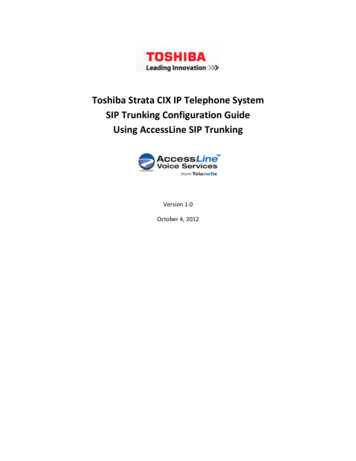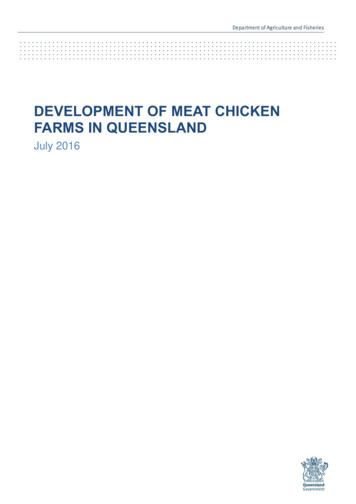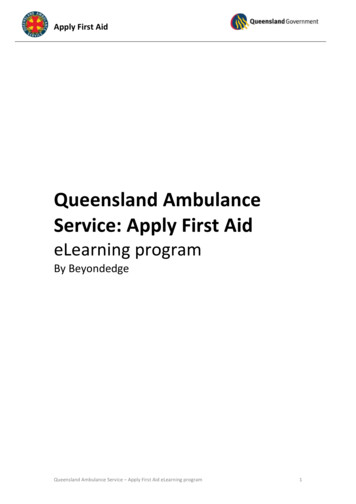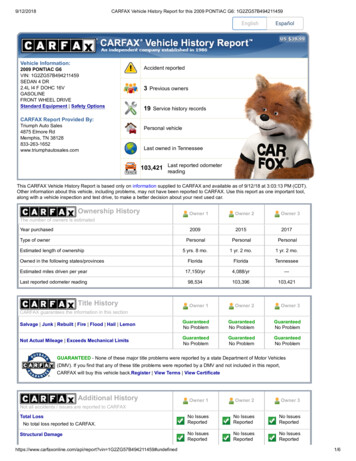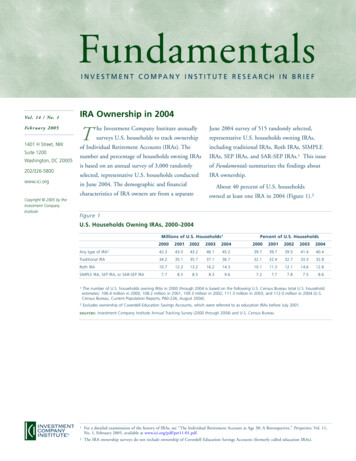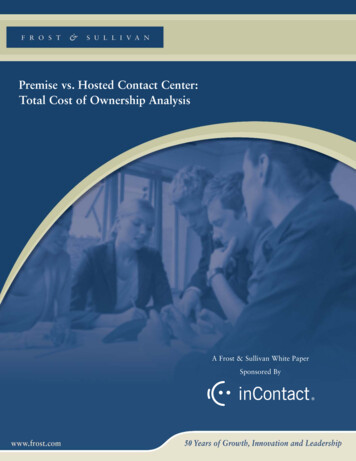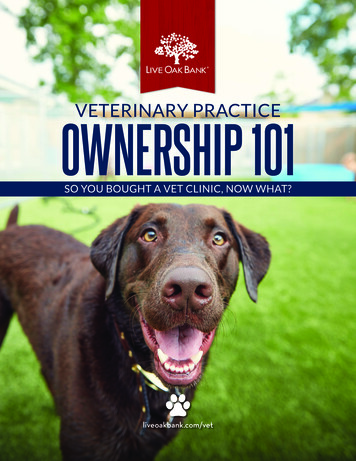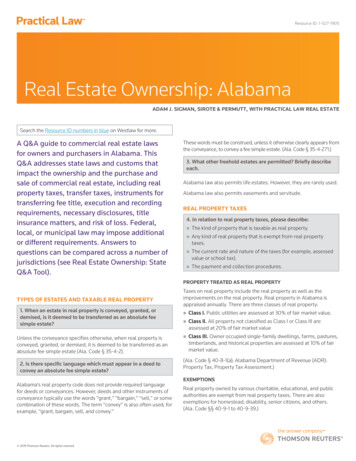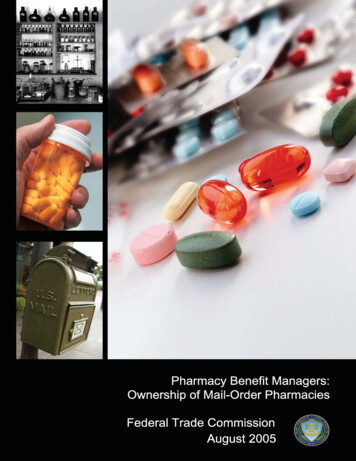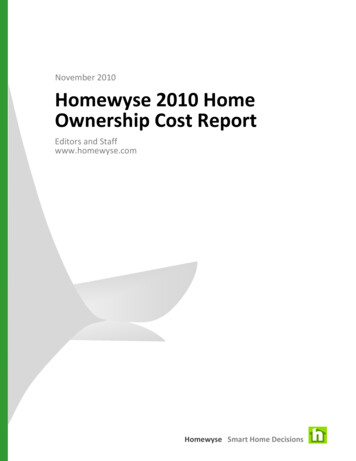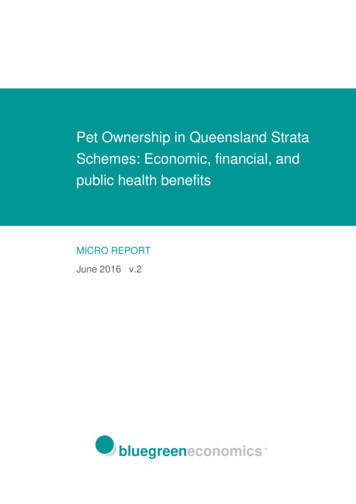
Transcription
Pet Ownership in Queensland StrataSchemes: Economic, financial, andpublic health benefitsMICRO REPORTJune 2016 v.2bluegreeneconomicsTM
About usBluegreen Economics is a social economics consultancy specialising in animal welfare andsocial policy. Utilising economics as the basis for our work, we take a unique approach tounderstanding and examining topics and policy issues by not only employing traditionaleconomic quantitative and qualitative methods but also by analysing, where necessary,technological, societal and political factors and influences.Bluegreen Economics was established in 2015 and is based in Brisbane, Australia.Bluegreen Economics Pty LtdACN 608 202 277PO Box 1343Toowong DC Qld 4066Email: stephen@bluegreeneconomics.com.auWeb: bluegreeneconomics.com.auCopyright 2016DisclaimerThis micro report has been prepared for the purposes of providing a succinct analysis of thestated topic. Micro reports prepared by Bluegreen Economics by their nature do not contain anextensive literature review or in-depth analysis and are prepared from time to time as publicinterest documents to draw attention to contemporary and emerging issues. These reports maynot examine every possible scenario and therefore should not necessarily be relied upon as acomprehensive consideration of the stated topic or issue. Bluegreen Economics accepts noresponsibility for any loss or damage suffered howsoever arising to any person or Corporationwho may use or rely on this report in contravention of the terms of this clause.Pet Ownership in Queensland Strata Schemes: Economic, financial and public health benefitsBLUEGREENECONOMICS.COM.AU06.20162
Executive SummaryPets are an integral part of many households with Australia having one of the highest levels ofpet ownership in the world. The peak body in Australia representing pet ownership and the petindustry, the Australian Companion Animal Council, estimates as at 2009 there wereapproximately 33 million pets in Australia: fish (55%); birds (24%); dogs (10%); cats (7%); other(4%). Thirty-six per cent of Australian households own a dog (3.41 million) and 23 per cent ofhouseholds own a cat (2.35 million).More recent Roy Morgan Research in 2015 confirms that nearly four in every ten Australians(38%) live in a household with a dog, 23 per cent of households have a cat, while 12 per cent ofhouseholds have both a dog and a cat with Queensland’s dog and cat ownership being slightlyhigher than the national average (39% dogs; 24% cats; 12% dog and cat).The total expenditure by consumers on pets, pet care products and services in Australia in 2009was 6.02 billion. Of this total pet care expenditure, by far the largest proportion of consumerpet care dollars is spent on dogs ( 3.6B/59.7%) and cats ( 1.42B/23.5%).There has been a marked shift in recent years away from traditional detached dwellings toapartment living in cities and larger regional towns. There has also been an increase in theproportion of people living in single-person households and couples choosing not to havechildren or having fewer children. Pets like dogs and cats are now very much consideredintegral to many family units, for some being a ‘substitute’ for children while for others a valuedcompanion providing psychological and emotional support and friendship.However, unlike detached dwellings (houses), strata schemes often do not allow pets or putunreasonable restrictions on the type of pets that may be kept. This means that not only arepotential first-time dog and cat owners barred from pet ownership, existing pet owners often arerequired to give up their beloved pet by having them rehomed or having them euthanised whenmoving to a strata apartment or townhouse. Thousands of dogs and cats are euthanised eachyear by local councils and some animal welfare organisations when owners can no longer carefor, or own, their pet. Undoubtedly there will be a small proportion of these attributed to movinginto strata schemes.While there is an emotional cost to pet owners when surrendering their beloved pets, suchprohibitions and restrictions also have other costs. With some reasonable assumptions, webroadly estimate the economic, financial and public health benefits that would likely be realisedwith legislative change to allow keeping a dog or cat in Queensland strata schemes by right:1.Approximately 90 - 180 million of increased expenditure and over 600 new jobs in thelucrative pet industry in the medium term (3 to 5 years).2.The current approximate 25,000 increase in value and 1,300/year increase in rentalincome for lot owners of an average 500,000 apartment/townhouse would decrease in somestrata schemes making strata purchases and renting more affordable.3.Budget savings for Queensland Health resulting from better public health outcomes.Pet Ownership in Queensland Strata Schemes: Economic, financial and public health benefitsBLUEGREENECONOMICS.COM.AU06.20163
Table of Contents Introduction - p.4 Queensland Strata Law for Pets - p.4 Economic, Financial and Public Health Benefits of Strata Pet Policy Reform - p.7oThe economic value of strata pet ownership to the economyoFinancial benefit to lot owners of pets in strata schemesoPublic health benefits of pet ownership in strata schemes Policy Setting Implications for Government – p.11 References – p.13IntroductionQueensland has over 42,000 strata schemes with around 393,000 individual lots 1. At the paceof strata construction in the state in the past 24 months the number of individual lots can beexpected to exceed 450,000 in 2017.In 2014, the Queensland Government commissioned a review of strata laws to modernise theBody Corporate and Community Management Act (1997). Undertaken by the QueenslandUniversity of Technology (QUT) Commercial and Property Law Research Centre, the reviewincludes an examination of strata by-laws, including the keeping of pets on strata allotments(apartments, townhouses, etc.)2. The review is expected to be finalised by the end of the year.This report focuses on the economic, financial and public health benefits of allowing individualstrata dwelling occupiers to keep a dog or a cat on their lot. While there will be other pets thatstrata residents may like to keep, we focus on these two animal types as they are the mostpopular pets kept by households.Queensland strata law for petsIn Queensland, strata schemes (bodies corporate, also known as Owners Corporations in somestates) are regulated by way of the Body Corporate and Community Management Act (1997)and its associated regulations (hereafter referred to as the ‘Act’). The Act contains a set ofmodel by-laws which in simple terms provides the body corporate with a standard suite of bylaws which may be applied to the strata scheme. These are often adopted by the ‘originalowner’ or developer unchanged or they sometimes will adopt these with minor amendments.1Department of Justice and Attorney-General (n.d.) Body Corporate: A quick guide to community living in Queensland. Onlinewww.justice.qld.gov.au/ data/assets/pdf f Accessed 27 January 20152QUT Commercial and Property Law Research Centre 2014. Queensland Government Property Law Review Options Paper Body CorporateGovernance Issues: By-laws, debt recovery and scheme termination http://www.justice.qld.gov.au/ data/assets/pdf -Governance-Options-Paper-1.pdf Accessed 11.04.2016Pet Ownership in Queensland Strata Schemes: Economic, financial and public health benefitsBLUEGREENECONOMICS.COM.AU06.20164
The model by-law for the Keeping of animals3 (with exception to guide, hearing or assistancedogs) is:(1) The occupier of a lot must not, without the body corporate’s written approval—(a) bring or keep an animal on the lot or the common property; or(b) permit an invitee to bring or keep an animal on the lot or the common property.(2) The occupier must obtain the body corporate’s written approval before bringing, orpermitting an invitee to bring, an animal onto the lot or the common property.The current model by-law places the power to allow pets in strata schemes in the bodycorporate, typically the committee which is elected at the annual general meeting or less oftenat an extraordinary general meeting. The historical explanation for the power to allow or disallowpets in strata schemes likely is a reflection of a time when animals were not considered ‘part ofthe family’ but a chattel which at law they still are to this day. However these days, due to morepeople living in single-person households and more couples choosing not to have children or tohave fewer children, pets like dogs and cats are very much part of the family unit.Strata schemes sometimes allow pets but apply strict criteria such as arbitrary weight limits e.g.10kg, or prohibitions on the type of pet that may be kept e.g. cat but not dog, as opposed to anoutright pet ban.However, while a strata scheme’s by-law may restrict or prohibit the keeping of pets, the Actrequires the body corporate to act reasonably in its decisions, both at general meetings in thepassing of by-laws and at the committee level where up to seven owners can make certaindecisions on behalf of the body corporate, albeit in a limited capacity.This overarching requirement to act reasonably is often not well understood by bodies corporateand committee members and in this regard there has been a wave of dispute applications overthe past few years in regard to the keeping of pets lodged at the Office of the Commissioner forBody Corporate and Community Management which operates a quasi-judicial dispute resolutionservice. Appeals to decisions by adjudicators, in certain circumstances, can be made to theQueensland Consumer and Administrative Tribunal (QCAT). This has resulted in a number ofdecisions finding many body corporate pet by-laws invalid resulting in orders to amend them.Two important decisions are Body Corporate for River City Apartments [2012] where theTribunal (QCAT) determined that a by-law that banned any pets was invalid as it did notregulate use but was an absolute prohibition and 212 on Margaret [2012] where a by-law thatsought to impose a weight restriction on permitted pets may be oppressive or unreasonable4.As part of the QUT strata law review, two options have been put forward by the reviewers toaddress the issue of pets in strata buildings.3Queensland Government Body Corporate and Community Management Act 1997 [current as at 22 March urrent/b/bodycorpa97.pdf Accessed 14.05.20164Cradduck, Lucy M. (2013) Parking, parties and pets : disputes - the dark side of community living. In 19th Annual Pacific-Rim Real EstateSociety Conference, 13-16 January 2013, RMIT University, Melbourne, VIC. (In Press)Pet Ownership in Queensland Strata Schemes: Economic, financial and public health benefitsBLUEGREENECONOMICS.COM.AU06.20165
Option 1 – No changeThe first option to address the issue of keeping pets is to maintain the status quo. This means thatbylaws about pets will be determined on a case by case basis. By‐laws prohibiting pets would continueto be prima facie invalid but this will be subject to a determination by an adjudicator based on the factsat the scheme.Schemes would be encouraged to adopt the standard pet by‐law from schedule 4 of the BCCM Act orto adopt reasonable conditions on keeping pets, based on the circumstances at the scheme. Theseconditions will have to be reasonable and not arbitrary limitations.Option 2 – ‘No pets’ by‐lawA second option for dealing with pets is to give bodies corporate the ability to pass and enforce a ‘nopets’ by‐law which completely prohibits keeping pets in a lot or on common property.In the River City decision the by‐law was held to be invalid because the body corporate has the abilityto regulate behaviour, not to prohibit it. The BCCM Act could be amended to expressly give the bodycorporate the ability to prohibit the keeping of pets in a lot.It is proposed that a ‘no pets’ by‐law should require a resolution without dissent to be adopted,amended or removed. As such, a ‘no pets’ by‐law would be unlikely to pass in a scheme where lotowners or occupiers already have pets. The legislation should provide that a ‘no pets’ by‐law may notcancel or remove any existing permission given by the body corporate to lot owners or occupiers tokeep a pet.Both of these options rely on the same underlying principle of the power vesting in the bodycorporate rather than the individual owner or the resident occupying their lot as discussed in thepreceding section. A third option should be considered, based on an owners’ rights policyprinciple, where the owner of a strata dwelling has similar property rights to an owner in a nonstrata dwelling e.g. suburban house, except to the extent that common property is involved.This principle is important for any substantial economic, financial and public health benefit to berealised as it focuses on the positives of pet ownership as opposed to the negatives that canarise from time to time of allowing pets in strata schemes e.g. unreasonable noise from barkingand common property soiling or damage, both of which can be mitigated by imposingreasonable conditions on the resident.This owners’ rights policy principle is acknowledged in respect to the keeping of pets in strataschemes by the peak body Urban Development Institute of Australia Queensland (UDIA Qld)5that states:The Institute is of the view that a resident’s right to own a pet ought to be protected. ‘No-pet’by-laws should not be allowed and be explicitly identified as invalid in legislation. The onlyexception to this would be where development approvals prohibit pets (due to proximity tofauna) or other State legislation forbids pets in certain non-residential uses.By-laws relating to pets should only exist in so far as they relate to nuisance caused by petsand owners. Any such requirements under by-laws should afford owners a reasonableperiod of time to rectify certain pet behaviours (e.g. barking).65Urban Development Institute of Australia (Qld) http://www.udiaqld.com.au/About-UsPet Ownership in Queensland Strata Schemes: Economic, financial and public health benefitsBLUEGREENECONOMICS.COM.AU06.20166
Economic, financial and public health benefitsof strata pet policy reformThe economic value of strata pet ownership to the economyThe peak body in Australia representing pet ownership and the pet industry, the AustralianCompanion Animal Council (ACAC)7, estimates as at 2009 there were just over 33 million petsin Australia. The majority of these pets are fish (55%) and birds (24%), with dogs (10%) andcats (7%) comprising 5.76 million of the total number. Thirty-six per cent of Australianhouseholds own a dog (3.41 million) and 23 per cent of households own a cat (2.35 million)8.More recent Roy Morgan Research in 2015 confirms that nearly four in every ten Australians(38%) live in a household with a dog, 23 per cent of households have a cat, while 12 per cent ofhouseholds have both a dog and a cat with Queensland’s dog and cat ownership being slightlyhigher than the national average (39% dogs; 24% cats; 12% dog and cat)9.The total expenditure by consumers on pets, pet care products and services in Australia in 2009was 6.02 billion. The breakdown of the total expenditure for all pets is shown in Table 1. Of thistotal pet care expenditure, by far the largest proportion of consumer pet care dollars is spent ondogs ( 3.6B/59.7%) and cats ( 1.42B/23.5%)10. In other words, approximately 5 billion/year isspent on dogs and cats nationwide.Table 1: Consumer expenditure on pets, 2009 (Australia) 11ItemPet foodPet care productsPet purchasesVeterinary servicesPet care servicesTotal million% of 100.00Table 2 shows the breakdown of consumer expenditure by state on dogs and cats which arelikely the most common pets in strata schemes where currently allowed. These companionanimals are the focus of this report analysis. Consumer expenditure in Queensland on dogs andcats in 2009 was just over one billion dollars ( 1.017B).This represents approximately 20.3 per cent of total expenditure Australia-wide.6Urban Development Institute of Australia Qld (UDIA) -Issues-UDIA-Submission.pdf.aspx 31 January 20157The ACAC includes as member organisations the Australian Veterinary Association (AVA) and the Australian Small Animal VeterinaryAssociation (ASAVA)8Australian Companion Animal Council (2010) Contribution of the pet care industry to the Australian economy, 7th Ed. Onlinehttp://www.acac.org.au/ACAC Report 2010.html Accessed 27 January 20159Roy Morgan Research 2015 ‘Doggone it: Pet ownership in Australia’ Available ip-inaustralia-2015 Accessed 08.03.201610Australian Companion Animal Council (2010) Contribution of the pet care industry to the Australian economy, 7th Ed. Onlinehttp://www.acac.org.au/ACAC Report 2010.html Accessed 27 January 201511Ibid.Pet Ownership in Queensland Strata Schemes: Economic, financial and public health benefitsBLUEGREENECONOMICS.COM.AU06.20167
Table 2: Consumer expenditure on dogs and cats by state, 2009 ( 12TotalTable 3 shows estimated employment in the pet care industry in four areas, being pet foodmanufacturing, pet care products, veterinary services and pet care services. While the tabledoes not breakdown the data into state figures, taking the 20.3 per cent expenditure forQueensland figure previously given, a broad estimate for employment in the pet care industry inQueensland for 2009 is 9,668 employed persons. The actual number of employed persons inQueensland could be higher or lower and would require further investigation however it is ourview that the number is unlikely to be significantly lower.Table 3: Estimated employment in the pet care industry, 200913Industryarea(Australia)Estimated employeesPet food manufacturing4,543Pet care products16,147Veterinary services20,600Pet care services6,337Total47,627From this data and with some reasonable assumptions applied, the increased economic activitycan be estimated in terms of expenditure on pets, pet care products and services andemployment in the pet industry in Queensland if dogs and cats were not prohibited in any stratadwellings.The following assumptions are made: ten per cent (10%) of strata lots currently have a dog/cat, given historic prohibitions ofpets in many strata schemes 450,000 lots in 2017 one dog/cat per lot (max. 450,000) expenditure on each dog/cat - 1,000 to 2,000/year14 one person employed per 136 dogs/cats in Queensland1512Ibid.Ibid.ASIC (2015) Getting a Pet. Online life-events/getting-a-pet Accessed 28 January 2015.Note: ASIC states the cost of owning a dog over its lifetime ranges from 13,000 to 25,000. Given most dogs do not live past 13 years of age,the expenditure per year is almost certain to be at least 1,000/year and up to around 2,000/year. From ACAC data presented, 1.017B/yearon 1,136,700 dogs cats Qld 894.00 per dog cat (year 2009) 1036.00 per dog cat (year 2015 assuming 2.5% annual inflation rate)15Employment in pet care industry 47,627 total employed in Australia x 20.3% 9,668 persons (Qld 2009) 10,000 (Qld 2017, estimated) 8,320 persons employed Qld for dogs cats (year 2015) based on 83.2% of pet care dollars 1 employee per 136 dogs cats (1,136,700 dogs cats/8,320 employed)1314Pet Ownership in Queensland Strata Schemes: Economic, financial and public health benefitsBLUEGREENECONOMICS.COM.AU06.20168
Table 4 shows the increase in expenditure and e
Jun 02, 2016 · Bluegreen Economics was established in 2015 and is based in Brisbane, Australia. Bluegreen Economics Pty Ltd ACN 608 202 277 PO Box 1343 Toowong DC Qld 4066 . potential first-time dog and cat owners barred from pet
